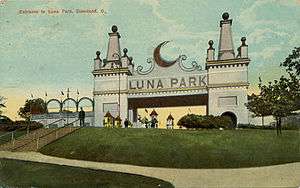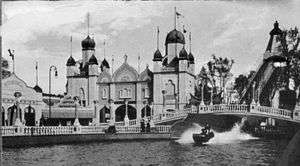Luna Park, Cleveland


Luna Park was a trolley park (a type of amusement park) in Cleveland, Ohio, USA, from 1905[1] to 1929.[2]
Specifications
Constructed by Frederick Ingersoll, the park occupied a hilly 35-acre (140,000 m2) site bounded by Woodland Avenue, Woodhill, Mt. Carmel, and East 110th Street and included roller coasters, carousels, a fun house, a Ferris wheel, a roller rink, a shoot-the-chutes ride, a concert shell, a dance hall, bumper cars, a baseball field,and a 20,000-seat[3] stadium (unofficially called "Luna Bowl", destroyed by 1929 fire) in which American football was played.[1] On May 18, 1905, Cleveland's Luna Park became the second Ingersoll park of that name (out of 44)[1][4] to have opened before his death in 1927, and the second amusement park (after Luna Park, Pittsburgh, which opened weeks earlier) to be covered with electrical lighting.[4]
History
The monetary demands of upgrading and maintaining his embryonic chain of amusement parks forced Ingersoll, the original owner of Cleveland's Luna Park, to declare bankruptcy in 1908;[5] Ingersoll was forced to sell his Cleveland park[1][6] to Matthew Bramley, an original investor in (and, later, owner of) Ingersoll's Luna Park Amusement Company who built the Cleveland Trinidad Paving Company into the largest paving company in the world.[7] Bramley added rides to Luna Park as its popularity as a trolley park grew, in part because beer was sold on the park grounds.[1] After the passage of the Eighteenth Amendment to the United States Constitution and the beginning of Prohibition (1920), a primary source of revenue was removed as the park's popularity waned. Bramley officially closed the gates to Luna Park in 1929 for the final time as the Great Depression took hold in the United States. The park was beset with incidences of arson, including the fire that destroyed the football stadium), and most of the rides were dismantled and moved to other amusement parks in the early 1930s.
Luna Bowl tenants
The Cleveland Panthers of the first American Football League and the Cleveland Bulldogs of the National Football League played their home games in Luna Bowl,[3] and (after the dismantling of the amusement rides had begun) Negro league baseball teams Cleveland Stars (1932), Cleveland Giants (1933), and Cleveland Red Sox (1934) each played their home games at the ballfield that was originally adjacent to the football stadium.[8] On December 12, 1938, the last vestige of the park, the skating rink, was destroyed by fire. In 1940, the Woodhill Homes housing development was built on the park site.
Collegiately, Case School of Applied Science defeated Western Reserve University 7–6 on November 19, 1927 during their annual rivalry football game, played only once at Luna Park.[9]
References
- 1 2 3 4 5 "Luna Park". The Encyclopedia of Cleveland History. Case Western Reserve University. March 27, 1998. Retrieved August 24, 2016.
- ↑ "History of the West Park Neighborhoods". WestParkHistory.com. Archived from the original on August 7, 2006. Retrieved August 24, 2016.
- 1 2 Greenberg, Murray (2008), Passing Game: Benny Friedman and the Transformation of Football, PublicAffairs, ISBN 1-58648-477-X
- 1 2 "Luna Park's luminary: Entrepreneur/roller coaster designer deserves his due". Pittsburgh Post-Gazette. September 1, 2008.
- ↑ Futrell, Jim (2002), Amusement Parks of Pennsylvania, Flagpole Books, ISBN 0-8117-2671-1
- ↑ Timeline: A Publication of the Ohio Historical Society, Ohio Historical Society, 2005.
- ↑ "Matthew Frederick Bramley". Encyclopedia of Cleveland History. Case Western Reserve University. July 14, 1997. Retrieved August 24, 2016.
- ↑ McKenna, Brian (September 4, 2007). "Negro League Ballparks". Baseball-Fever.com. Retrieved August 24, 2016.
- ↑ "Case Football 1927/28 Season Record". Case.edu. Case Western Reserve University. Retrieved August 24, 2016.
External links
| Wikimedia Commons has media related to Luna Park, Cleveland. |
- First-year tour of Cleveland's Luna Park
- Timeline of additions to Cleveland's Luna Park, 1906-1925
- Luna Park, Cleveland at the Roller Coaster DataBase
Coordinates: 41°29′23″N 81°36′42″W / 41.48972°N 81.61167°W